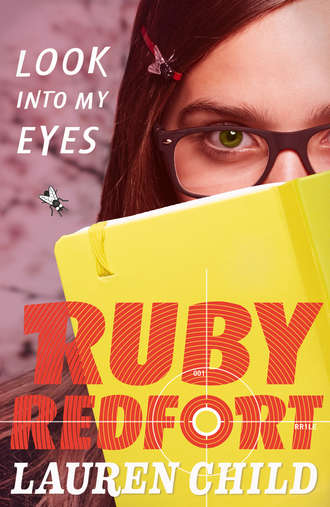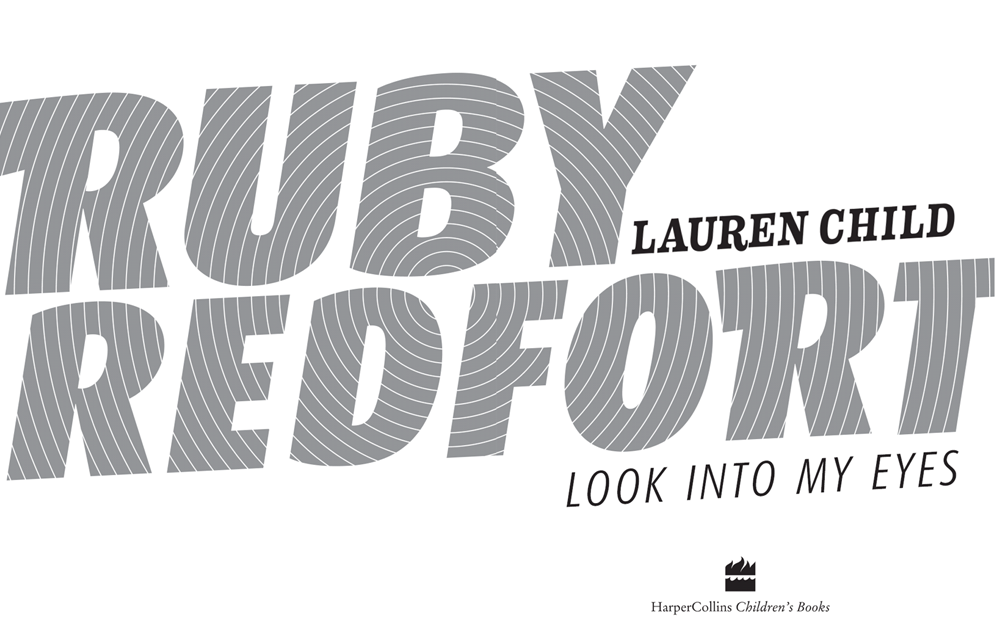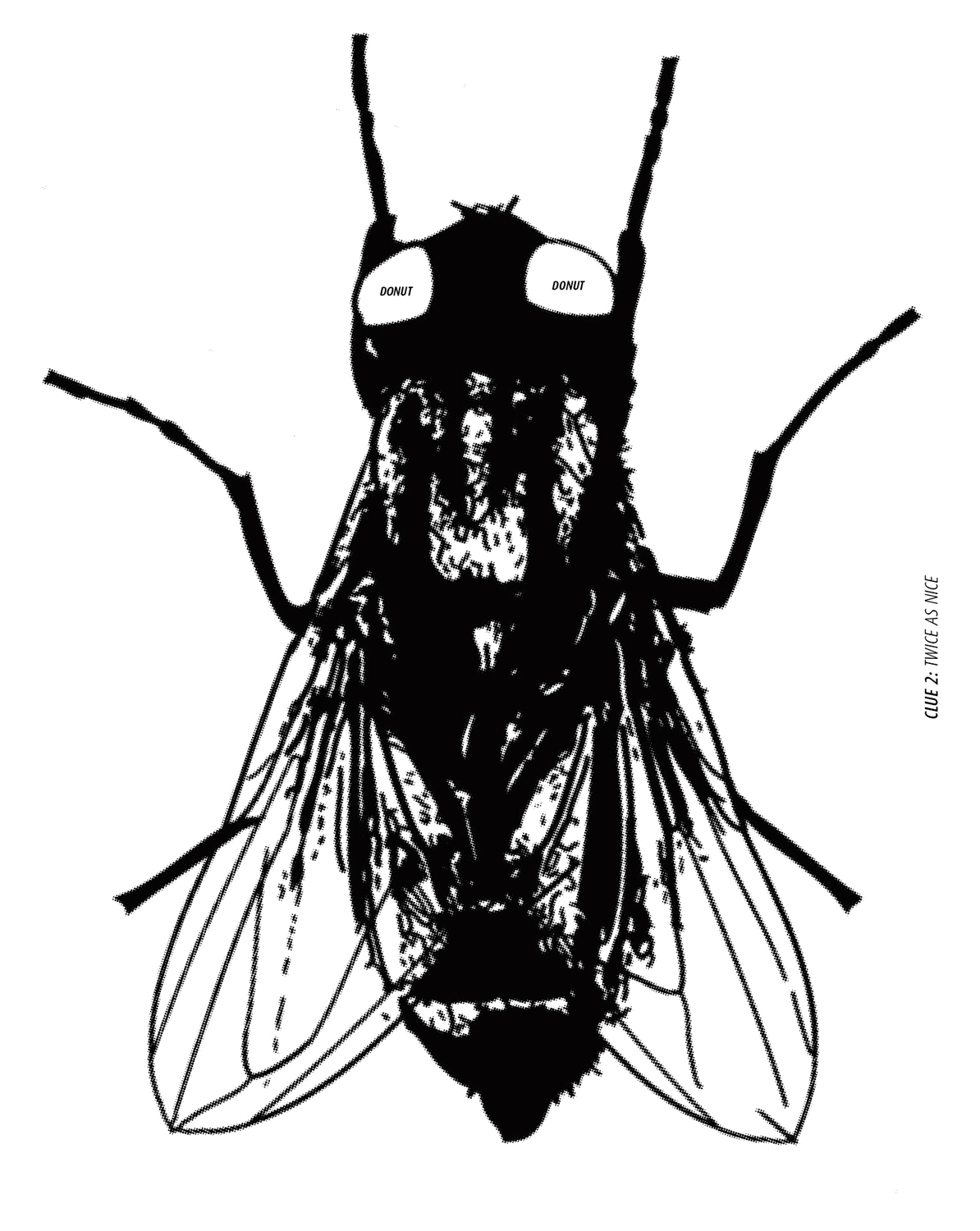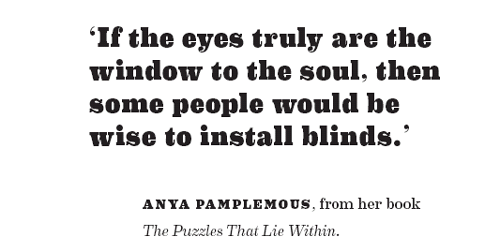
Полная версия
Look into My Eyes




Copyright
HarperCollins Children's Books An imprint of HarperCollinsPublishers Ltd. 1 London Bridge Street London SE1 9GF
www.harpercollins.co.uk
First published in 2011
Copyright © Lauren Child 2011
Lauren Child asserts the moral right to be identified as the author of this work
All rights reserved under International and Pan-American Copyright Conventions. By payment of the required fees, you have been granted the nonexclusive, nontransferable right to access and read the text of this ebook on-screen. No part of this text may be reproduced, transmitted, downloaded, decompiled, reverse-engineered, or stored in or introduced into any information storage and retrieval system, in any form or by any means, whether electronic or mechanical, now known or hereinafter invented, without the express written permission of HarperCollins ebooks
HarperCollinsPublishers has made every reasonable effort to ensure that any picture content and written content in this ebook has been included or removed in accordance with the contractual and technological constraints in operation the time of publication
Source ISBN: 9780007334063
Ebook Edition © SEPTEMBER 2011 ISBN: 9780007447428
Version: 2017-08-18
Dedication
For AD
Epigraph

Contents
Cover
Title Page
Copyright
Dedication
Epigraph
There was a girl called Ruby
An Ordinary Kid
Chapter 1. You can never be completely sure what might happen next
Chapter 2. There’s a lot of truth in fiction
Chapter 3. ‘Sounded like dessert’
Chapter 4. Full of nothing
Chapter 5. More of nothing
Chapter 6. Fifteen dollars and forty-nine cents
Chapter 7. Don’t call us we’ll call you
Chapter 8. Getting Lucky
Chapter 9. A small dark space
Chapter 10. The voice
Chapter 11. The eyes followed the hands
Chapter 12. The silent G
Chapter 13. As good as gold
Chapter 14. Don’t erase me
Chapter 15. Strictly confidential
Chapter 16. Don’t look now
Chapter 17. Strange and uneasy
Chapter 18. If in doubt, say nothing
Chapter 19. One little lie
Chapter 20. Unlikely but not impossible
Chapter 21. The blink of an eye
Chapter 22. Don’t breathe a word
Chapter 23. Funny peculiar
Chapter 24. A total yawn
Chapter 25. Some likely suspects
Chapter 26. The little brown box
Chapter 27. A formula for murder
Chapter 28. Secretly super
Chapter 29. A Regular Girl
Chapter 30. Room Service
Chapter 31. When you’re out, you’re out
Chapter 32. The advantage
Chapter 33. Crisp and lean
Chapter 34. ‘They could feed my toes to a pack of vultures but I would never blab’
Chapter 35. Nine Lives
Chapter 36. A colony of vultures
Chapter 37. Time waits for no man
Chapter 38. The sands of time
Chapter 39. Lucky twice
Chapter 40. Look into my eyes
Cat Woman
Keep Reading
Acknowledgments
About the Author
About the Publisher
There was a girl called Ruby
IT WAS A CRISP OCTOBER DAY in Cedarwood Drive and a two-year-old girl was standing on a high stool in front of a huge picture window. She was watching the leaves fall, studying the patterns they made as they whirled their way through the air. Her eyes followed them until her gaze was caught by a single yellow leaf, almost exactly the shape of a hand. She watched as it swooped down into the yard and then sailed up high over the fence and across the street. She watched as it danced up and down in the breeze and then slapped flat onto the windshield of a passing truck.
The truck pulled up in front of old Mr Pinkerton’s grey clapboard house. The driver climbed out, walked up the path and knocked on the door. Mr Pinkerton stepped out onto the porch and the driver produced a map – the two men struck up a conversation.
Exactly one minute later an elegant woman turned the corner, carrying a large green picnic basket. With a glance to the house and the slightest nod from the driver, the woman slipped out of her heels, scooped them up and nimbly scaled Mr Pinkerton’s fence. Mr Pinkerton was busy studying the map and noticed nothing; the child saw everything. Forty-five seconds passed and the woman reappeared: she was carrying the same basket but it looked much heavier than before and its contents seemed to be moving.
The little girl attempted to grab her parents’ attention but since her use of language was still limited she could not get them to understand. She watched as the woman pushed her feet back into her black shoes, walked to the rear of the truck and out of view. Mr Pinkerton chatted on. The girl jumped up and down, pointing at the window. Her parents, sensing she might be eager for a walk, went to put on their coats.
The child drew a truck on her chalkboard.
Her father smiled and patted her on the head. Meanwhile, the driver folded his map, thanked Mr Pinkerton and returned to his vehicle – waving to him as he drove off. The yellow hand-shaped leaf fluttered to the ground. The woman, now minus the picnic basket, walked on by. She had a fresh scarlet scratch on her left cheek.
The child spelled out the truck’s license plate with her alphabet blocks.
Her mother tidied them away and dressed her in a red woollen bobble hat and matching mittens.
The family left the house and strolled down Cedarwood drive. When they reached the grey clapboard house, the little girl paused to pick up the yellow leaf, and there underneath it, found a small tin badge embossed with an image of something. What was it?
A sudden cry shook the stillness of Cedarwood Drive. A cry that cut right through the heart of the child. She gripped the badge tightly and felt the pin dig into her palm. The neighbours came spilling out onto the street to find the kindly Mr Pinkerton doubled up with grief. Despite the best efforts of the Twinford Crime Investigation Squad – a search which continued for sixteen weeks – Mr Pinkerton’s prize-winning Pekinese dog was never seen again.
It was on that October day that the little girl resolved to dispense with the toddler talk and brush up on her language skills. More importantly, that was the day she set her sights on becoming a detective.
The little girl was Ruby Redfort.
An Ordinary Kid
WHEN RUBY REDFORT WAS SEVEN YEARS OLD she won the Junior Code-Cracker Championships – solving the famous Eisenhauser conundrum in just seventeen days and forty-seven minutes. The following year she entered the ‘Junior Code-Creator Contest’ and stunned the judges when they found her code impossible to break. In the end it was sent to Harvard University professors, who eventually managed to solve it two weeks later. She was immediately offered a place for the following semester but declined. She had no interest in becoming, as she put it, some kind of geek freak.
Some several years later…
Chapter 1.
You can never be completely sure what might happen next
RUBY REDFORT WAS PERCHED ON a high stool in front of the bathroom window, her binoculars trained on a cake delivery truck that had been parked on Cedarwood Drive for precisely twenty-one minutes. So far no one had emerged from the truck with so much as a blueberry muffin. Ruby gurgled down the last dregs of her banana milk and made a note in the little yellow notebook which lay in her lap. She had 622 of these yellow notebooks; all but one was stashed under her bedroom floorboards. Though she had taken up this hobby nine years ago, no one, not even her best friend Clancy, had read a single word she had written. Much of what Ruby observed seemed pretty mundane but EVEN THE MUNDANE CAN TELL A STORY {RULE 16}.
Ruby also kept a vivid pink notebook, dog-eared and smelling of bubble gum, and it was in this that she listed her Ruby rules – there were seventy-nine so far.
RULE 1: YOU CAN NEVER BE COMPLETELY SURE WHAT MIGHT HAPPEN NEXT. A truth no one could argue with.
Ruby was a petite girl, small for her years – at first glance a very ordinary looking kid. There was nothing particular to mark her out – that is, nothing until you looked a little longer. Then you would begin to see that her eyes were ever so slightly different shades of green. When they looked at you it was somehow hard to remember the point you were arguing. And when she smiled she revealed small doll-like teeth which somehow made it impossible to consider her anything other than a cute kid. But the most striking thing about Ruby Redfort was that when you met her you felt a strong need for her to like you. The bathroom phone rang; lazily, Ruby reached out and groped for the receiver.
‘Brandy’s wig salon, hair today, gone tomorrow.’
‘Hi Rube,’ came back the voice on the other end; it was Clancy Crew.
‘So Clance, what gives?’
‘Not a whole lot actually.’
‘So to what do I owe the pleasure of this call?’
‘Boredom,’ yawned Clancy.
‘So why don’t you get yourself over here, bozo?’
‘Well, I would you know Rube but my dad wants me home – he’s got some kinda embassy type function and he wants us all smiling, you know what I mean?’
Clancy Crew’s father was an ambassador and there was always some function or other in progress. Ambassador Crew liked to have his children scrubbed and serving canapés to prove what a great family guy he was – though truth to tell he was usually too busy to even remember their birthdays.
‘Some people have all the fun,’ drawled Ruby.
‘Yeah, my life stinks,’ said Clancy.
‘So cheer yourself up why don’tcha. Scoot yourself over, watch a few toons and you’ll still be home in time to smile for the camera.’
‘OK Rube, you’ve talked me into it, see you in ten.’
Ruby put down the phone. It lived on a shelf with two others: one was in the shape of a conch shell, the other disguised as a bar of soap. She had a whole lot more of them in her bedroom. She had been collecting telephones since she was about five years old, all in different shapes and colours. The donut phone was her first – the latest, a cartoon squirrel sporting a tuxedo. Just about all of them had come from yard sales.
She was about to continue her bathroom-based surveillance when the intercom buzzed – Ruby’s parents had sensibly fitted them on each floor to keep shouting to a minimum.
She pressed the ‘speak’ button.
‘Hello, how may I be of assistance?’
‘Howdy,’ came the voice from the other end of the intercom. ‘This is Mrs Digby, your housekeeper, may I please remind you that your parents will be home from Switzerland in two and a quarter hours.’
‘I know, Mrs Digby, you told me that a half hour ago.’
‘Glad you remembered. May I also point out that they may be a little grief stricken to see the state of your bedroom.’
‘It’s my style Mrs Digby – “layered”– it’s very in vogue.’
‘Well may I continue to remind you that some magazine folks are coming to photograph this very house tomorrow and if your mother sees it in its “layered” state, you will be in what’s commonly referred to as “the dog house”.’
‘OK, OK,’ sighed Ruby, ‘I’ll take care of it.’
The Redfort house, dubbed the Green-Wood house, on account of its environmental features, had been designed in 1961 by famous architect Arno Fredricksonn. Even now, a decade or so later it was still considered very state of the art and was regularly featured in architectural journals.
Ruby returned to the bathroom, sat back down on her stool and continued to stare out of the window; the truck was still there but now there was a raccoon sitting on its roof. The bathroom door pushed open and in ambled a large husky dog, which sniffed around before settling down to chew the bathmat.
‘Bored, huh?’ said Ruby, slipping off her stool. She padded into her bedroom and surveyed the wreckage. It was not a pretty sight. Ruby wasn’t so much untidy as she was a spreader – she had a lot of stuff and when she was busy working on something the stuff had a habit of creeping from one surface to another and this was what her mother did not like.
Darn it! muttered Ruby. If the magazine people were coming, her mom would just about freak if this was what they saw. She could almost hear her father saying, ‘for the sake of your mother’s sanity – do something Ruby.’ So she set about slipping records back into their sleeves and pushing books onto shelves. Ruby had a lot of books; they were arranged floor to ceiling across one end of her room.
A FICTION SECTION:
both English and foreign titles.
FACTUAL:
comprising anything.
GRAPHIC NOVELS AND COMICS:
subject – largely crime and mystery.
Ruby and Mrs Digby had a shared enthusiasm for crime and thrillers: fact or fiction, whether in book form or on the screen. They would often settle down with a large bowl of blue corn chips and watch the quiz show What’s Your Poison? or when Ruby was several years younger, Mrs Digby would settle Ruby to sleep by reading one of her favourite Crime thrillers, The Claw at the Window.
PUZZLES:
Puzzles were Ruby’s passion.
Any kind of puzzle: crosswords, anagrams, riddles, even jigsaws – anything that needed to be solved by finding the ‘pattern’ the ‘trick’ or the ‘key’. This had led Ruby to…
CODES:
She had read many books and essays on the subject.
In fact she was a subscriber to Master Code Monthly, a little known Chinese subscription-only magazine. Subscribers had to prove their code-cracking talent before they were permitted to sign up. It was this journal that had led her to read the following:
* Garp Einholt’s, The Theory of Code, its Abstract Duality and Subtext (to be honest Ruby had found this very overstated and not a little tedious).
* Sherman Tree’s more vital Unlock My Brain.
* Anya Pamplemous’s thirty year study of codes, The Puzzles That Lie Within, which she also very much enjoyed.
But her personal handbooks were both written many centuries ago, one, by the Greek philosopher, Euclid with the simple title of X, the other, a tiny indigo book (origin unknown) which was filled with all manner of codes. It explained riddles and poems and equations – patterns, symbols and sounds. It was a code breaker’s bible.
Having dealt with the books, records and papers, Ruby began the more complex task of sorting through clothes; all of which seemed to be on the floor of her closet. It was here, underneath a pile of knee-high striped socks, that she unearthed her glasses.
Boy, am I glad to see you!
Although Ruby would on occasion wear contact lenses she didn’t much care for them; they had a habit of falling out at exactly the wrong moment. If Ruby Redfort had an Achilles heel, it was her eyes; without some sort of visual aid life was just a blur.
There was another buzz from the intercom. ‘Yuh huh?’
‘What are you doing?’
‘Being tidy – why?’
‘Just checking.’
‘Mrs Digby, you are one suspicious woman.’
Having put away as many of her clothes as she could be bothered to put away, Ruby grabbed all the remaining garments and stuffed them down the laundry chute. She was in the habit of tipping all sorts of things down the laundry chute – even, on occasion, herself. It saved time.
Judging her work finished, Ruby’s finger hovered over the TV’s ‘on’ switch, but her attention was caught by what sounded like activity in the kitchen. Seven years ago she had rigged up a reverse periscope device so she could see what was occurring in the kitchen below. Today she saw Mrs Digby taking a fresh batch of cookies out of the oven.
Nice work Mrs Digby.
She slid her notebook carefully inside the hollowed out doorframe, and went downstairs.
RULE 2: IF YOU WANT TO KEEP SOMETHING SECRET, DON’T LEAVE IT LYING AROUND.
Chapter 2.
There’s a lot of truth in fiction
WHEN RUBY ENTERED THE STYLISH, modern kitchen, she was automatically handed a vile-smelling green drink. Ruby glared at Mrs Digby, bearer of the unfortunate liquid.
Mrs Digby shrugged. ‘Don’t look at me, it’s your mother’s orders – she wants you to grow.’ Sabina was always trying to get Ruby to eat foods that might promote growth. ‘Personally I don’t see what’s so wrong with being short,’ Mrs Digby added. ‘I’ve always been short and it’s never stopped me from getting by in the world.’
This was true. Mrs Digby was probably one of the smallest and most determined people one could meet. She had been with the Redforts long before Ruby was born and before that she was housekeeper to Ruby’s mother’s parents. Her face resembled an autumn leaf – dry and covered in lines. When she applied lipstick, it bled along the tiny cracks around her mouth, creating miniature rivulets. She was getting on in years but no one was exactly sure of her age – if asked she usually answered, ‘sixty, seventy, eighty, who’s counting? Not me that’s for darn sure.’
Mrs Digby spoiled Ruby whenever possible but never, ever, went against Mrs Redfort’s dietary instructions. Sabina Redfort was always putting her household under one health regime or another and Ruby and her father dreaded them all.
Ruby took the drink without arguing, brought it to her lips and said, ‘Mrs Digby, could I have just one cookie, just to take the taste away?’
Mrs Digby considered the request for a mere moment. ‘Well, your mother didn’t say you couldn’t – so I guess it would be all right.’ She turned her back just for a second, maybe two, and in this tiny moment Ruby poured the drink down the sink, having been careful to first make sure she got some of the green liquid on her upper lip.
‘Yuck!’ said Ruby.
‘There’s a miserable kid,’ said the housekeeper, wiping Ruby’s face as if she were still just a toddler. Mrs Digby looked at Ruby’s T-shirt, which bore the statement some days stink and muttered, ‘well, who can argue with that.’
She paused.
‘On second thought your mother will. If I were you I might avoid the trouble by changing into something, you know – frilly.’
Ruby made a face – ‘frilly’ was neither in her vocabulary nor her wardrobe. As far as her attire went, she was more often than not dressed in jeans, sneakers, a T-shirt printed with either a somewhat hostile word: bozo, an interesting number: 1729, or some less than agreeable statement: bored beyond belief. But she knew what Mrs Digby meant and she knew she had a point.
The backstairs door opened and in walked a young woman followed by three large boxes of heirloom tomatoes balanced on a pair of skinny legs.
‘Hola Ruby, how are you?’ said the woman.
‘Bien gracias Consuela,’ replied Ruby. ‘Hey, is that you under there, Clance?’
‘I think so,’ muttered Clancy, struggling to heave the boxes onto the counter. He rolled his eyes. ‘I’ll just go and fetch the others.’ Clancy was a good-natured person – mostly he tended to like people, but he didn’t much like Consuela. Too bossy. Mrs Digby was no big fan either.
The trouble had begun when Sabina Redfort rather rashly decided that Mrs Digby’s cooking was too stodgy and that they should adopt a more olive oil and tomato based diet. This had led to the hiring of dietary expert Consuela Cruz. Consuela had been flown over from Seville, Spain, along with many suitcases and countless cooking utensils, and though her salary was eye-watering, Mrs Redfort considered her to be worth every penny.
The new diet, however, may have been helping maintain healthy hearts but it certainly wasn’t generating much love. Mrs Digby made a muttering sound deep in her throat and Consuela clucked her tongue and both women left the room by different doors. Ruby, now alone, piled several cookies on to a plate (ten to be exact) and went about making herself some more appealing drinks (two banana milks with strawberry ice-cream). The banana milk was imported from Europe, for though Brant Redfort had tried, it seemed impossible to find anywhere inside the USA.
Ruby popped straws in both drinks and carefully carried them out of the kitchen – sucking on one of the straws as she went. She was about to climb the stairs, when she caught sight of the little light on the answer phone flashing to indicate a message. She pressed play.
‘Hey there Redfort gang! It’s the Humberts here – Freddie and I were just saying how much we would like it if you all came over – and Quent would just adore to see darling Ruby! Call us back won’t you! Bye bye bye!’
This voice belonged to Marjorie Humbert, a family friend, wife of Freddie Humbert the Twinford City Bank manager and mother of Quent the dullest boy in town. Ruby automatically pressed ‘erase’ and continued on her way. She was followed by the large husky.
‘Hey there Bug,’ cooed Ruby, ‘wanna watch some TV?’
When she entered her room she caught sight of herself in the mirror. Mrs Digby was right: if she wanted to avoid a whole lot of grief she might want to put on a dress. She rummaged through her closet until she found an interesting red and white number she had picked up at a thrift store – if Ruby wore anything other than jeans and T-shirts, then it was usually second hand. She was one of those girls who people talked about as ‘having her own style,’ which was sometimes meant as a compliment and sometimes not. The hem of the dress was secured with sticky-tape, but one hardly noticed if one wasn’t looking too closely.
Ruby pulled on some black over the knee socks and a pair of Yellow Stripe sneakers. The dress still retained its thrift store odour, so Ruby sprayed herself with some perfume. (Oriental Rose: she had a sizeable collection of beautifully bottled fragrances which, when worn mingled with the odour of the bubblegum she so often chewed, creating a unique Ruby Redfort fragrance.)
Clancy had not yet reappeared so Ruby carried the tray of snacks up the open-tread staircase which connected her room to the rooftop. She liked to sit up here on warm evenings looking at the stars, writing in her notebook, reading and, more than occasionally, watching the portable TV. She settled down in the beanbag, in one hand a cookie and in the other a large green apple. She believed that the healthy attributes of the apple might counteract the bad effects of the cookie. (Ruby Redfort had a lot of theories like this one.)








